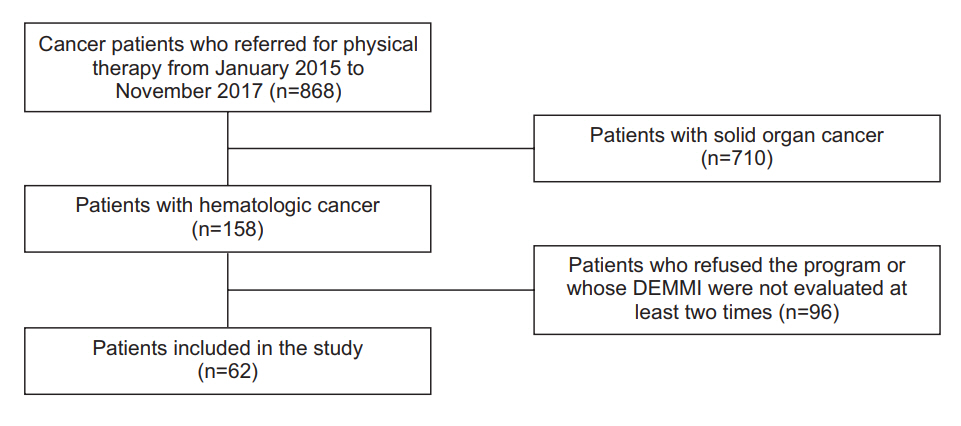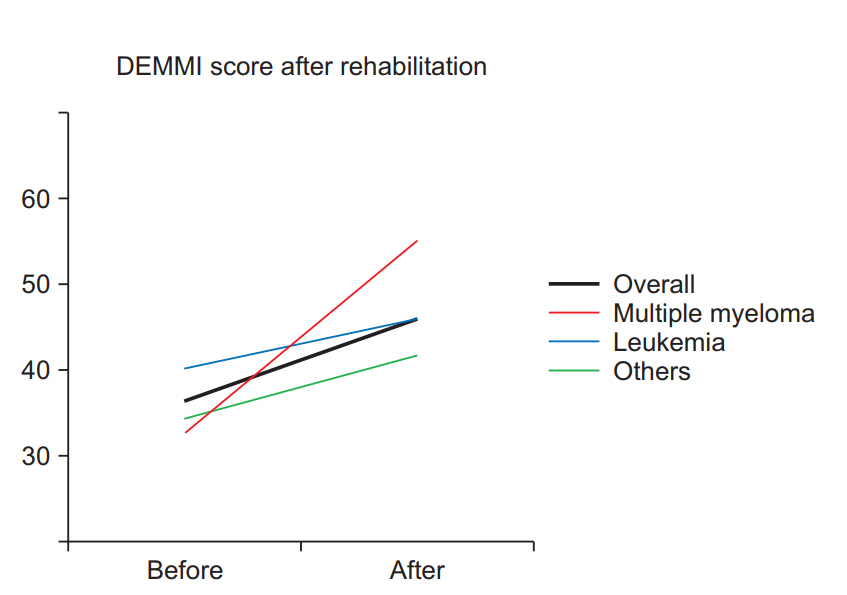Ann Rehabil Med.
2018 Dec;42(6):838-845. 10.5535/arm.2018.42.6.838.
Effect of an Inpatient Rehabilitation Program for Recovery of Deconditioning in Hematologic Cancer Patients After Chemotherapy
- Affiliations
-
- 1Department of Rehabilitation Medicine, Seoul National University Hospital, Seoul National University College of Medicine, Seoul, Korea. snurm@daum.net
- 2Division of Hematology, Department of Internal Medicine, Seoul National University Hospital, Seoul National University College of Medicine, Seoul, Korea.
- 3Department of Rehabilitation Medicine, SMG-SNU Boramae Medical Center, Seoul, Korea.
- KMID: 2448905
- DOI: http://doi.org/10.5535/arm.2018.42.6.838
Abstract
OBJECTIVE
To investigate the effect of a rehabilitation program in terms of De Morton Mobility Index (DEMMI) score, in hematologic cancer patients after chemotherapy.
METHODS
Hematologic cancer patients admitted for chemotherapy were reviewed. They received a rehabilitation program during their hospital stay. DEMMI score measurement was performed, before and after rehabilitation. Demographics, diagnosis, chemotherapy information, rehabilitation program duration, mortality, body mass index (BMI), and laboratory test results were collected. For analysis, patients were classified according to diagnosis (multiple myeloma, leukemia, and others), mortality, and additional chemotherapy.
RESULTS
There was statistically significant improvement in DEMMI score of 10.1 points (95% confidence interval, 5.9-14.3) after rehabilitation. It was more evident in the multiple myeloma group, and they revealed less mortality. When patients were divided according to mortality, survivors received the program earlier, and in a shorter period than in mortality cases. Although survivors revealed higher initial DEMMI score, improvement after rehabilitation did not differ significantly.
CONCLUSION
In hematologic cancer patients, rehabilitation program was effective for recovery from deconditioning, revealing significant increase in DEMMI score. Multiple myeloma patients may be good candidates for rehabilitation. Rehabilitation could be sustained during chemotherapy and for high-risk patients.
Keyword
MeSH Terms
Figure
Reference
-
1. Harrington CB, Hansen JA, Moskowitz M, Todd BL, Feuerstein M. It’s not over when it’s over: long-term symptoms in cancer survivors: a systematic review. Int J Psychiatry Med. 2010; 40:163–81.2. Speck RM, Courneya KS, Masse LC, Duval S, Schmitz KH. An update of controlled physical activity trials in cancer survivors: a systematic review and metaanalysis. J Cancer Surviv. 2010; 4:87–100.
Article3. Spence RR, Heesch KC, Brown WJ. Exercise and cancer rehabilitation: a systematic review. Cancer Treat Rev. 2010; 36:185–94.
Article4. Dimeo F, Schwartz S, Fietz T, Wanjura T, Boning D, Thiel E. Effects of endurance training on the physical performance of patients with hematological malignancies during chemotherapy. Support Care Cancer. 2003; 11:623–8.
Article5. Cook G, Williams C, Brown JM, Cairns DA, Cavenagh J, Snowden JA, et al. High-dose chemotherapy plus autologous stem-cell transplantation as consolidation therapy in patients with relapsed multiple myeloma after previous autologous stem-cell transplantation (NCRI Myeloma X Relapse [Intensive trial]): a randomised, open-label, phase 3 trial. Lancet Oncol. 2014; 15:874–85.
Article6. Majhail NS, Farnia SH, Carpenter PA, Champlin RE, Crawford S, Marks DI, et al. Indications for autologous and allogeneic hematopoietic cell transplantation: guidelines from the American Society for Blood and Marrow Transplantation. Biol Blood Marrow Transplant. 2015; 21:1863–9.7. Stolar K, Alousi A, Neumann J, Champlin R. Hematologic cancer survivorship management: transplantation. In : Foxhall L, Rodriguez M, editors. Advances in cancer survivorship management. New York: Springer;2015. p. 167–86.8. Persoon S, Kersten MJ, Buffart LM, Vander Slagmolen G, Baars JW, Visser O, et al. Health-related physical fitness in patients with multiple myeloma or lymphoma recently treated with autologous stem cell transplantation. J Sci Med Sport. 2017; 20:116–22.
Article9. Baz R, Lin HM, Hui AM, Harvey RD, Colson K, Gallop K, et al. Development of a conceptual model to illustrate the impact of multiple myeloma and its treatment on health-related quality of life. Support Care Cancer. 2015; 23:2789–97.
Article10. Paul KL. Rehabilitation and exercise considerations in hematologic malignancies. Am J Phys Med Rehabil. 2011; 90(5 Suppl 1):S88–94.
Article11. Mello M, Tanaka C, Dulley FL. Effects of an exercise program on muscle performance in patients undergoing allogeneic bone marrow transplantation. Bone Marrow Transplant. 2003; 32:723–8.
Article12. Stout NL, Baima J, Swisher AK, Winters-Stone KM, Welsh J. A systematic review of exercise systematic reviews in the cancer literature (2005-2017). PM R. 2017; 9(9S2):S347–S384.
Article13. Maltser S, Cristian A, Silver JK, Morris GS, Stout NL. A focused review of safety considerations in cancer rehabilitation. PM R. 2017; 9(9S2):S415–S428.
Article14. de Morton NA, Davidson M, Keating JL. The de Morton Mobility Index (DEMMI): an essential health index for an ageing world. Health Qual Life Outcomes. 2008; 6:63.
Article15. Oldervoll LM, Loge JH, Paltiel H, Asp MB, Vidvei U, Wiken AN, et al. The effect of a physical exercise program in palliative care: a phase II study. J Pain Symptom Manag. 2006; 31:421–30.
Article16. Inui A. Cancer anorexia-cachexia syndrome: current issues in research and management. CA Cancer J Clin. 2002; 52:72–91.
Article17. Gilchrist LS, Galantino ML, Wampler M, Marchese VG, Morris GS, Ness KK. A framework for assessment in oncology rehabilitation. Phys Ther. 2009; 89:286–306.
Article18. Bower JE. Cancer-related fatigue: mechanisms, risk factors, and treatments. Nat Rev Clin Oncol. 2014; 11:597–609.19. Davenport SJ, Paynter S, de Morton NA. What instruments have been used to assess the mobility of community-dwelling older adults? Phys Ther Rev. 2008; 13:345–54.
Article20. Galanos AN, Pieper CF, Cornoni-Huntley JC, Bales CW, Fillenbaum GG. Nutrition and function: is there a relationship between body mass index and the functional capabilities of community-dwelling elderly? J Am Geriatr Soc. 1994; 42:368–73.
Article21. Antoun S, Baracos VE, Birdsell L, Escudier B, Sawyer MB. Low body mass index and sarcopenia associated with dose-limiting toxicity of sorafenib in patients with renal cell carcinoma. Ann Oncol. 2010; 21:1594–8.
Article22. Coleman EA, Coon S, Hall-Barrow J, Richards K, Gaylor D, Stewart B. Feasibility of exercise during treatment for multiple myeloma. Cancer Nurs. 2003; 26:410–9.
Article23. Craike M, Hose K, Livingston PM. Physical activity participation and barriers for people with multiple myeloma. Support Care Cancer. 2013; 21:927–34.
Article24. Shallwani S, Dalzell MA, Sateren W, O’Brien S. Exercise compliance among patients with multiple myeloma undergoing chemotherapy: a retrospective study. Support Care Cancer. 2015; 23:3081–8.
Article25. Oechsle K, Jensen W, Schmidt T, Reer R, Braumann KM, de Wit M, et al. Physical activity, quality of life, and the interest in physical exercise programs in patients undergoing palliative chemotherapy. Support Care Cancer. 2011; 19:613–9.
Article26. Alfano CM, Cheville AL, Mustian K. Developing highquality cancer rehabilitation programs: a timely need. Am Soc Clin Oncol Educ Book. 2016; 35:241–9.
Article27. Silver JK, Raj VS, Fu JB, Wisotzky EM, Smith SR, Kirch RA. Cancer rehabilitation and palliative care: critical components in the delivery of high-quality oncology services. Support Care Cancer. 2015; 23:3633–43.
Article28. Blaney J, Lowe-Strong A, Rankin J, Campbell A, Allen J, Gracey J. The cancer rehabilitation journey: barriers to and facilitators of exercise among patients with cancer-related fatigue. Phys Ther. 2010; 90:1135–47.29. Yang EJ, Chung SH, Jeon JY, Seo KS, Shin HI, Hwang JH, et al. Current practice and barriers in cancer rehabilitation: perspectives of Korean physiatrists. Cancer Res Treat. 2015; 47:370–8.
Article
- Full Text Links
- Actions
-
Cited
- CITED
-
- Close
- Share
- Similar articles
-
- Correction: Effect of an Inpatient Rehabilitation Program for Recovery of Deconditioning in Hematologic Cancer Patients After Chemotherapy
- Concept Analysis: Deconditioning
- The Influence of Depressive Symptoms on Cognitive and Functional Recovery in Chronic Stroke Patients
- Launching of the accreditation system for rehabilitation facility in Korea
- Short-Term Inpatient Pulmonary Rehabilitation for Pneumoconiosis



